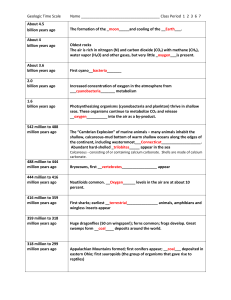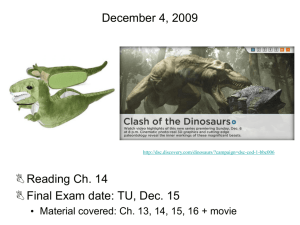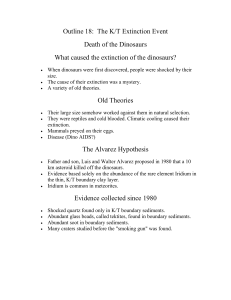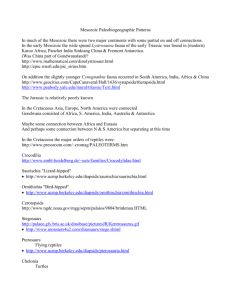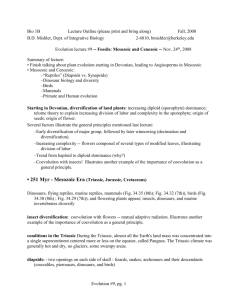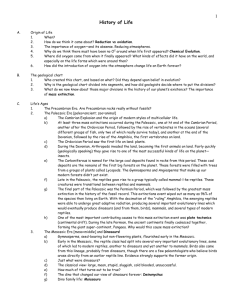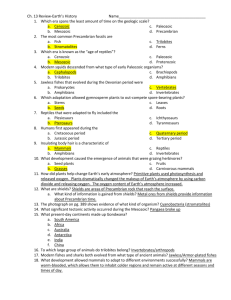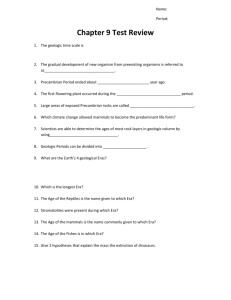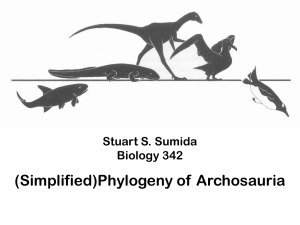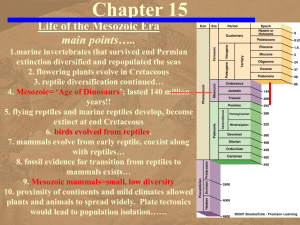Mesozoic Life
advertisement
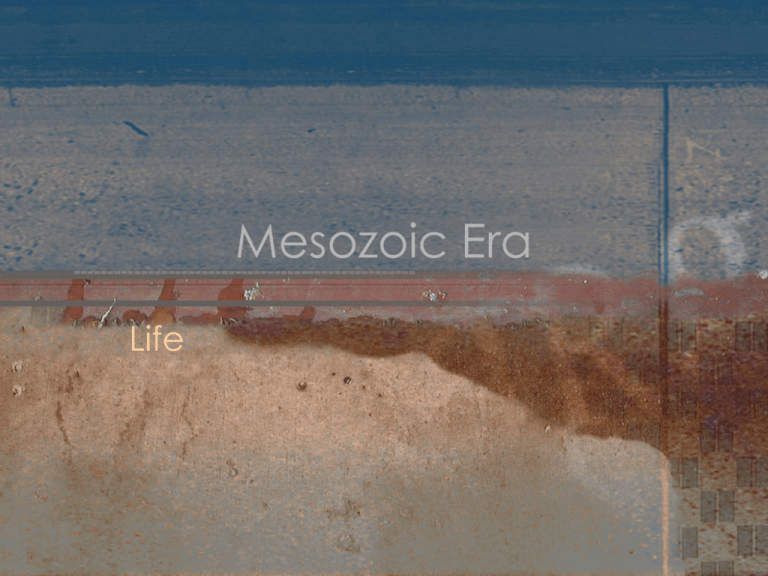
Mesozoic Era Life Mesozoic Life • Known as “Age of Reptiles” • Mammals and angiosperms evolve Marine Invertebrates Plankton • Coccolithophores – 1st appeared (Jur) – Abundant (K) – Continue today • Diatoms (SiO2) – 1st evolved (K) – Cold H2O • Dinoflagellates – Warm H2O • Foraminifera – Exploded • Most plankton extinct (end K) Marine Invertebrates Corals & Echinoderms • Corals & Echinoderms proliferated Scleractinians Echinoderm Mollusks Brachiopods & Gastropods • Significant invertebrate fauna • Brachiopods – Never fully recovered from Permian extinction – Minor invertebrate • Gastropods – Largest, most varied class – Marine, fresh H2O, terrestrial – Herbivore & carnivore Mollusks Bivalves • Burrowing organism – Escaped predators – i.e., oysters, clams – Rudists significant Formed large tropical reefs Excellent guide fossils Mollusks Cephalopods Cephalopod Nautilus • Important invertebrate group • Ammonites – Complex sutures – Abundant (Jr & K), extinct (end K) • Nautiloids and belemnoids survived Mesozoic Life Fishes and Amphibians • Bony fish – ↑ abundance • Amphibians – Frogs and salamanders appear – Greatest diversity (Permian) Mesozoic Life Plants • Primary producers – base of food chain • Gymnosperms – Gingkos – Conifers – Cycads Modern cycads • Gymnosperms replaced by angiosperms Gymnosperm Angiosperm Plants Angiosperms • Adapted to nearly every terrestrial habitat • Factors to success: – Method of reproduction Evolution of flowers • Pollinators Evolution of enclosed seed • Seeds dispersed by wind, fruit, burr Mesozoic Life Reptiles • Diversification began during Penn – Evolution of protorothyrids 1st to lay amniote egg All other reptiles evolved • Thecodontian (L. Per-Tri) – Small, agile reptiles with long tails, short limbs – Teeth set in sockets i.e. crocs, dinos, & mammal-like reptiles – Quadrupedal, ran bipedal – Herbivores & carnivores – Dinosaur ancestors Warm-Blooded Dinosaurs • Ectotherm – “cold-blooded” – Animals whose body temp varies in response to outside temp • All reptiles ectothermic • Endotherm – “warm-blooded” – Capable of maintaining a constant body temp regardless of outside temp • Mammals & birds endothermic • Dinosaurs believed to be endothermic Warm-Blooded Dinosaurs • Endotherm requirements – Dino bones numerous passageways = blood flow Crocs, turtles have similar bone structure = ectotherm – High metabolic rates need to eat more Dinosaurs 3.5% prey pop’n Similar to present-day mammals – Complex nervous system large brain Many dinos have small brains Small carnivores = large brain – Active flight requires endothermy Pterosaurs = hair-like feathers Triceratops brain cavity Mesozoic Life Dinosaurs Relationships • Two independent orders evolved 1. Saurischia “lizard-hipped” – Theropod & Sauropod 2. Ornithischia “bird-hipped” Dinosaurs Saurischia Theropod • Theropods – “Carnivores” – Bipedal locomotion – Various sizes 60 cm to 15 m 2 kg to 8 tons – Tyrannosaurus (largest terrestrial carnivore) – Deinonychus – “terrible claw” Dinosaurs Saurischia Sauropod • Sauropods – “Herbivores” – Quadruped locomotion – Largest land animals to ever exist 20 to 35 m in length 10 to 55 tons Camasaurus “Brontosaur” Brachiosaurus Diplodocus Mesozoic Life Dinosaurs Relationships • Two independent orders evolved 1. Saurischia – Theropod & Sauropod 2. Ornithischia Dinosaurs 5 groups Ornithischia 1. Duck-billed dinos (K) – Colonial nesting, cared for young, herbivores, bipedal 2. Pachycephalosaurs – Dome-shaped skull, bipedal, butting 3. Ankylosaurs – Armored, quadrupeds, tail w/ club-like growth 4. Stegosaurs – Quadruped, herbivore with spike on tail 5. Certopsian – Triceratops, quadrupedal herbivores Mesozoic Life Winged Dinosaurs • Pterosaurs – 1st flying vertebrates – Flight adaptations Winged membrane supported by elongated finger • Pteranodon (K) – Pterosaur – Could actively fly Mesozoic Life Birds • Few Meso birds – Archaeopteryx Jur strata, Germany – Protoavis (Tri) Crow sized Hollow bones Mesozoic Life Early Mammals • 1st mammals (Tri) – Small, rodent-like mammals – Evolved from Therapsids Mammal-like reptiles • Cynodonts – Most abundant mammal-like reptile Early Mammals • Monotremes Cynodonts – Egg-laying – i.e. today’s platypus & string anteater • Eupantotheres – Marsupials – pouched (E. K) – Placental mammals – All living mammals related to this branch Mesozoic Life From Reptile to Mammal • Used skeletal structure to classify fossils – Skull – Middle ear – Lower jaw – Teeth – – – – Mammal’s middle ear attached to dentary Reptiles = 1 ear bone; mammals = 3 Reptile = several jaw bones; mammals = 1 Teeth = distinct types Reptile vs. Mammal Comparison Mesozoic Era Mass Extinction • Impact Theory – Huge asteroid or comet – Cloud of dust into atmosphere – Reduced sunlight Plants die first Herbivores followed Then, carnivores starved Mass Extinction Evidence • Large impact basin • Iridium-rich clay layers – Rare crustal rock – More in meterorites • Clay layers, New Mexico Mass Extinction Problems • Selective extinction – Dinosaurs completely extinct – Corals, clams, snails – some extinction – Tropical plants, crocodiles, mammals, turtles, snakes, & birds unaffected • Why weren’t all organisms affected equally?
